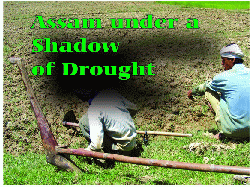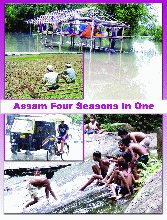Archives
Assam Under a shadow of drought
Assam Under a shadow of drought
 Assam which is also a place where the mighty Brahmaputra flows is known for recurring floods every year. It is all thanks to the change in climate pattern that Assam is today facing a natural disaster in the form of drought. The government of Assam in mid July declared that 14 districts of the state are facing a drought like situation. The districts are Bongaigaon, Cachar, Dhubri, Goalpara, Golaghat, Kailakandi, Jorhat, Kanpur, Karbi-Anglong, Kokrajhar, Lakhimpur, Morigaon, Nagoan and Sivsagar. Of late the government of Assam has declared the entire state as an agricultural drought state.
Assam which is also a place where the mighty Brahmaputra flows is known for recurring floods every year. It is all thanks to the change in climate pattern that Assam is today facing a natural disaster in the form of drought. The government of Assam in mid July declared that 14 districts of the state are facing a drought like situation. The districts are Bongaigaon, Cachar, Dhubri, Goalpara, Golaghat, Kailakandi, Jorhat, Kanpur, Karbi-Anglong, Kokrajhar, Lakhimpur, Morigaon, Nagoan and Sivsagar. Of late the government of Assam has declared the entire state as an agricultural drought state.
Because of the drought, the price of potatoes or onions has reached an all time high in the state as the production of both has dropped 30 to 40%
as stated by Mr. Vinod Jain, Secretary Guwahati Potato Onion Merchant Association. The shortfall in the supply is being met by bringing these items in from as far as Faridabad, Dhubguri (North Bengal), Patna, Rajasthan and Nasik. On the other hand, Agriculture Minister of Assam Pramila Rani Brahma blamed it on global warming. According to her, global warming has posed a serious problem before the farmers of Assam as the water bodies started drying up and the ground water level has gone down sharply over the years. Consequent to the drought, the state agricultural growth rate is showing a negative trend.
It has been learnt that the agricultural department of Assam has submitted two proposals to the state government suggesting measures for disaster management and calamity relief in view of the drought like situation. Sources say that the purchase of 832 numbers of 5 HP Capacity Diesel Pump sets as permanent farmers irrigation program has been proposed. It is proposed that these Pump sets will be temporarily provided to the farmers to overcome the drought like situation. The provision of financial assistance of Rs. 1250 to two neighbouring farmers for irrigation purpose has also been proposed. With this assistance, the farmer will be able to procure fuel for the pump sets. Four lakh farmers are proposed to be covered under this scheme and the areas sought to be covered under it is 2 lakh hectares. However changes in the number of beneficiaries may take place in areas depending on the local conditions.
The state government has fixed a target of 18 lakh hectares of land to be covered under Sali Paddy this time. The estimated production of rice during this Sali (winter paddy) season is 29.25 lakh metric tonnes. The state has fixed a target to produce 46.67 lakh metric tonnes of rice during 2009-10 against an estimated requirement of 39.47 lakh metric tonnes. This means that, for the first time, the government is planning to have a surplus paddy production in spite of adverse climatic conditions. Experts feel that this is not likely to be achieved.
The Tea Industry in Assam is also facing a crisis because of deficit rainfall and prolonged dry spells. The areas of Golaghat, Jorhat, Karbi-Anglong and Nagaon Districts are most affected and it is presumed that many tea gardens in the region will not survive because of this extraordinary situation. This  has resulted in a decline in productivity and quality and has become a serious issue of concern for the tea planters. A major factor behind the qualitative and quantitative decline has been the existence of large areas of cultivation having tea bushes over 50 years old. While as much as 38% of the country’s tea growing areas is considered uneconomic, Assam accounts for half of this unproductive area. Solving the problem is proposed through re-plantation with a Special Purpose Tea Fund (SPTF) which is now in operation.
has resulted in a decline in productivity and quality and has become a serious issue of concern for the tea planters. A major factor behind the qualitative and quantitative decline has been the existence of large areas of cultivation having tea bushes over 50 years old. While as much as 38% of the country’s tea growing areas is considered uneconomic, Assam accounts for half of this unproductive area. Solving the problem is proposed through re-plantation with a Special Purpose Tea Fund (SPTF) which is now in operation.

